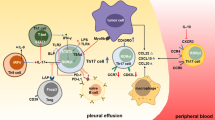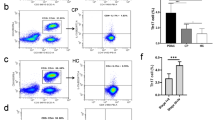Abstract
Th0 cells differentiate into Th1 or Th2 depending on multiple transcription factors acting on specific time points to regulate gene expression. Th17 cells, a subset of IL-17-producing T cells distinct from Th1 or Th2 cells, have been described as key players in inflammation and autoimmune diseases as well as cancer development. In the present study, 53 patients with hypopharyngeal cancer were included. The expression levels of Th1-, Th2- and Th17-associated cytokines in hypopharyngeal cancer tissues and pericarcinoma tissues were detected. The relationship between Th1, Th2, or Th17 infiltration and metastasis was studied. Our results showed that the mRNA and protein expressions of Th1 cytokines were lower, while the expressions of Th2 and Th17 cytokines were higher in tumor tissues, and the intensity of expression was strengthened with clinical stage increasing. Cancer tissues had higher level expressions of Th2 and Th17 cytokines than that of pericarcinoma tissues. From the above data, we speculated that high expressions of Th2- and Th17-associated cytokines in hypopharyngeal carcinoma may contribute to cancer development and metastasis.




Similar content being viewed by others
References
Tosolini M, Kirilovsky A, Mlecnik B et al (2011) Clinical impact of different classes of infiltrating T cytotoxic and helper cells (Th1, Th2, Treg, Th17) in patients with colorectal cancer. Cancer Res 71:1263–1271
Su Z, Sun Y, Zhu H et al (2014) Th17 cell expansion in gastric cancer may contribute to cancer development and metastasis. Immunol Res 58:118–124
Mantovani A, Allavena P, Sica A, Balkwill F (2008) Cancer-related inflammation. Nature 454:436–444
Zhu J, Paul WE (2010) Heterogeneity and plasticity of T helper cells. Cell Res 20:4–12
Hirahara K, Ghoreschi K, Laurence A, Yang XP, Kanno Y, O’Shea JJ (2010) Signal transduction pathways and transcriptional regulation in Th17 cell differentiation. Cytokine Growth Factor Rev 21:425–434
Wei H, Sun R, Xiao W et al (2004) Type two cytokines predominance of human lung cancer and its reverse by traditional Chinese medicine TTMP. Cell Mol Immunol 1:63–70
Dong C (2006) Diversification of T-helper-cell lineages: finding the family root of IL-17-producing cells. Nat Rev Immunol 6:329–333
Bettelli E, Carrier Y, Gao W et al (2006) Reciprocal developmental pathways for the generation of pathogenic effector TH17 and regulatory T cells. Nature 441(7090):235–238
Yang XO, Pappu BP, Nurieva R et al (2008) T helper 17 lineage differentiation is programmed by orphan nuclear receptors ROR alpha and ROR gamma. Immunity 28:29–39
Ouyang W, Kolls JK, Zheng Y (2008) The biological functions of T helper 17 cell effector cytokines in inflammation. Immunity 28:454–467
Maruyama T, Kono K, Mizukami Y et al (2010) Distribution of Th17 cells and FoxP3(+) regulatory T cells in tumor-infiltrating lymphocytes, tumor-draining lymph nodes and peripheral blood lymphocytes in patients with gastric cancer. Cancer Sci 101:1947–1954
Gaur P, Singh AK, Shukla NK, Das SN (2014) Inter-relation of Th1, Th2, Th17 and Treg cytokines in oral cancer patients and their clinical significance. Hum Immunol 75:330–337
Wrzesinski SH, Wan YY, Flavell RA (2007) Transforming growth factor-beta and the immune response: implications for anticancer therapy. Clin Cancer Res 13:5262–5270
Jakowlew SB (2006) Transforming growth factor-beta in cancer and metastasis. Cancer Metastasis Rev 25:435–457
Chen XM, Xu XQ, Sun K, Hallett WH, Zhao JD, Zhang DL (2008) NKG2D ligands expression and NKG2D-mediated cytotoxicity in human laryngeal squamous carcinoma cells. Scand J Immunol 67:441–447
Maarof G, Bouchet-Delbos L, Gary-Gouy H, Durand-Gasselin I, Krzysiek R, Dalloul A (2010) Interleukin-24 inhibits the plasma cell differentiation program in human germinal center B cells. Blood 115:1718–1726
Jemal A, Siegel R, Xu J, Ward E (2010) Cancer statistics, 2010. CA Cancer J Clin 60:277–300
Hall SF, Groome PA, Irish J, O’Sullivan B (2008) The natural history of patients with squamous cell carcinoma of the hypopharynx. Laryngoscope 118:1362–1371
Cooper JS, Porter K, Mallin K et al (2009) National Cancer Database report on cancer of the head and neck: 10-year update. Head Neck 31:748–758
Sasaki CT, Jassin B (2001) Cancer of the pharynx and larynx. Am J Med 111:118S–123S
Takes RP, Strojan P, Silver CE et al (2012) Current trends in initial management of hypopharyngeal cancer: the declining use of open surgery. Head Neck 34:270–281
Chan JY, Wei WI (2013) Current management strategy of hypopharyngeal carcinoma. Auris Nasus Larynx 40:2–6
Gourin CG, Terris DJ (2004) Carcinoma of the hypopharynx. Surg Oncol Clin N Am 13:81–98
Buckley JG, MacLennan K (2000) Cervical node metastases in laryngeal and hypopharyngeal cancer: a prospective analysis of prevalence and distribution. Head Neck 22:380–385
Kotwall C, Sako K, Razack MS, Rao U, Bakamjian V, Shedd DP (1987) Metastatic patterns in squamous cell cancer of the head and neck. Am J Surg 154:439–442
Robson A (2002) Evidence-based management of hypopharyngeal cancer. Clin Otolaryngol Allied Sci 27:413–420
Allal AS (1997) Cancer of the pyriform sinus: trends towards conservative treatment. Bull Cancer 84:757–762
Murugaiyan G, Saha B (2009) Protumor vs antitumor functions of IL-17. J Immunol 183:4169–4175
Mosmanm TR, Sad S (1996) The expanding universe of T-cell subsets: Th1, Th2 and more. Immunol Today 17:138–146
Yamamura M, Modlin RL, Ohmen JD, Moy RL (1993) Local expression of antiinflammatory cytokines in cancer. J Clin Invest 91:1005–1010
Oshikawa K, Yanagisawa K, Ohno S, Tominaga S, Sugiyama Y (2002) Expression of ST2 in helper T lymphocytes of malignant pleural effusions. Am J Respir Crit Care Med 165:1005–1009
Chen YM, Yang WK, Whang-Peng J, Tasi CM, Perng RP (2001) An analysis of cytokine status in the serum and effusions of patients with tuberculous and lung cancer. Lung Cancer 31:25–30
Kharkevitch DD, Seito D, Balch GC, Maeda T, Balch CM, Itoh K (1994) Characterization of autologous-specific T-helper 2 cells in tumor-infiltrating lymphocytes from a patient with metastatic melanoma. Int J Cancer 58:317–323
Chtanova T, Mackay CR (2001) T cell effector subsets: extending the Th1/Th2 paradigm. Adv Immunol 78:233–266
Agarwal S, Misra R, Aggarwal A (2008) Interleukin 17 levels are increased in juvenile idiopathic arthritis synovial fluid and induce synovial fibroblasts to produce proinflammatory cytokines and matrix metalloproteinases. J Rheumatol 35(3):515–519
Gu Y, Hu X, Liu C, Qv X, Xu C (2008) Interleukin (IL)-17 promotes macrophages to produce IL-8, IL-6 and tumour necrosis factor-alpha in aplastic anaemia. Br J Haematol 142:109–114
Nabeshima K, Inoue T, Shimao Y, Sameshima T (2002) Matrix metalloproteinases in tumor invasion: role for cell migration. Pathol Int 52:255–264
Li A, Dubey S, Varney ML, Dave BJ, Singh RK (2003) IL-8 directly enhanced endothelial cell survival, proliferation, and matrix metalloproteinases production and regulated angiogenesis. J Immunol 170:3369–3376
Miyahara Y, Odunsi K, Chen W, Peng G, Matsuzaki J, Wang RF (2008) Generation and regulation of human CD4+ IL-17-producing T cells in ovarian cancer. Proc Natl Acad Sci USA 105:15505–15510
Zhang B, Rong G, Wei H et al (2008) The prevalence of Th17 cells in patients with gastric cancer. Biochem Biophys Res Commun 374:533–537
Lee JJ, Chang YL, Lai WL et al (2011) Increased prevalence of interleukin-17-producing CD4(+) tumor infiltrating lymphocytes in human oral squamous cell carcinoma. Head Neck 33:1301–1308
Chi LJ, Lu HT, Li GL et al (2010) Involvement of T helper type 17 and regulatory T cell activity in tumour immunology of bladder carcinoma. Clin Exp Immunol 161:480–489
Su X, Ye J, Hsueh EC, Zhang Y, Hoft DF, Peng G (2010) Tumor microenvironments direct the recruitment and expansion of human Th17 cells. J Immunol 184:1630–1641
Wainwright DA, Sengupta S, Han Y, Ulasov IV, Lesniak MS (2010) The presence of IL-17A and T helper 17 cells in experimental mouse brain tumors and human glioma. PLoS One 5:e15390
Cantini G, Pisati F, Mastropietro A et al (2011) A critical role for regulatory T cells in driving cytokine profiles of Th17 cells and their modulation of glioma microenvironment. Cancer Immunol Immunother 60:1739–1750
Zhou P, Sha H, Zhu J (2010) The role of T-helper 17 (Th17) cells in patients with medulloblastoma. J Int Med Res 38:611–619
Acknowledgments
The present study was supported by grants from the Natural Science Foundation of Shandong Province (No. ZR2013HL028, ZR2010CM067), Shandong Province Outstanding Young Scientist Award Fund (No. BS2009SW007), the Special Research Foundation of Large Scientific Instruments on Upgrading and Technological Transformation of Shandong Province (No. 2013SJGZ09) and the Seed Foundation of the Second Hospital of Shandong University (No. S2013010021).
Author information
Authors and Affiliations
Corresponding authors
Rights and permissions
About this article
Cite this article
Chen, X., Wang, J., Wang, R. et al. Th1-, Th2-, and Th17-associated cytokine expression in hypopharyngeal carcinoma and clinical significance. Eur Arch Otorhinolaryngol 273, 431–438 (2016). https://doi.org/10.1007/s00405-015-3779-2
Received:
Accepted:
Published:
Issue Date:
DOI: https://doi.org/10.1007/s00405-015-3779-2




